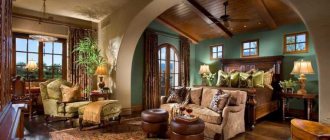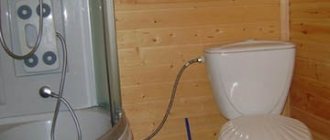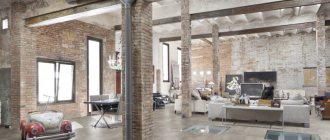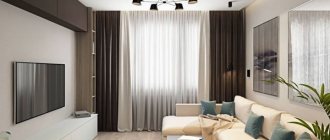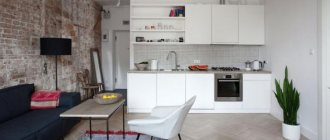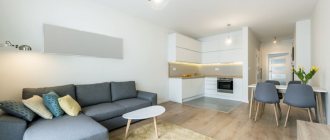Click to share
more
How can we design a small toilet design? The toilet is one of the most important rooms in an apartment or house, and it defines us as civilized people. It is important that the toilet is functional and comfortable, as well as clean and hygienic. There are many things to consider when designing a toilet. So how to choose a small toilet design and arrange it correctly? How to choose furniture, decoration and accessories? What else is important to remember? About this in our article.
Here we will look at all the elements that should be considered when designing a small toilet.
Wall decoration with white brick: pros and cons
White brick is used quite often in the interior. It can be combined with the design of almost any room, and therefore will be an excellent solution for implementing many stylistic ideas. A white brick wall has its pros and cons. They allow you to understand whether it will be possible to implement design ideas using this element.
| Pros of white brick | Cons of white brick |
| 1. White elements in interior design visually increase the space. 2. With the help of white brick in the interior you can revive almost any style. 3. White brick masonry is available in different price categories and from different materials. 4. Suitable for bedroom, kitchen, hallway, living room and many other rooms. 5. Dense masonry provides good sound insulation. 6. Visually smoothes the uneven surface of the wall. | 1. A room with such renovation requires regular cleaning. 2. A panel made of gypsum and similar materials is afraid of moisture. 4. Professional finishing from natural materials will not be cheap. |
Masonry nets
Masonry nets and other products can be purchased at Leroy Merlin in Moscow at low prices. Select the product you are interested in on the website and buy it in our online store. The range of products presented in the catalog is extremely wide. Among them there will certainly be a position suitable in all respects.
All products presented in the “Masonry mesh” section are produced by well-known companies that have proven themselves to be of high quality for their products.
You can always place an order and pay for it online on the official website of Leroy Merlin in Russia. For residents of the Moscow region, we not only have low prices for goods in the “Masonry mesh” category, but also fast delivery to cities such as Moscow, Balashikha, Podolsk, Khimki, Korolev, Mytishchi, Lyubertsy, Krasnogorsk, Elektrostal, Kolomna, Odintsovo, Domodedovo , Serpukhov, Shchelkovo, Orekhovo-Zuevo, Ramenskoye, Dolgoprudny, Pushkino, Reutov, Sergiev Posad, Voskresensk, Lobnya, Ivanteevka, Dubna, Yegoryevsk, Chekhov, Dmitrov, Vidnoye, Stupino, Pavlovsky Posad, Naro-Fominsk, Fryazino, Lytkarino, Dzerzhinsky , Solnechnogorsk, Istra and Zhukovsky.
White brick in interior styles
White bricks can be combined with various interior styles. The main thing is to know what accents need to be made and where to emphasize the uniqueness of the combination for the sake of the interior design.
Scandinavian style
White decorative brick in a Scandinavian style interior should play one of the leading roles. Nordic design notes love cool and light colors, so it is better not to choose small areas. Large white brickwork will be appropriate on the entire surface of the wall of a living room, bedroom or hallway in a Scandinavian style.
Loft
In the loft style, surfaces finished with red brick or other materials with “natural” shades are more common. But the good thing about this style is that it combines many unusual solutions with an emphasis on brevity and a challenge to glamor. An imitation of natural white brick would be appropriate in a nursery or living room. To enhance the brightness of the style, it is worth choosing contrasting decorative elements, black or brown, made of wood and metal.
Provence
In the Provence style, the material is appropriate only in the interior of the kitchen: a small apron with neat masonry will become a bright accent of the room, which should not be overloaded with an abundance of other decorative elements.
Classic
Classic and white brick go well together. The material or its imitation would be appropriate in the living room. The white masonry above the fireplace will be the highlight of the room.
boho
White brick tiles in a boho interior will reduce the brightness level. It can be used to decorate the wall of a living room, bedroom or kitchen. To emphasize the ethnic boho mood, the masonry is decorated with hanging decor - carpets, jewelry, masks with fringe made from natural fabrics and materials.
High tech
Interior design in high-tech style is rich in dark, cool shades: gray, black, dark brown. The combination with a white brick wall will be advantageous if the masonry imitates natural material. It is better to cover the surface with glossy varnish and not use dense textures.
English style
This direction has absorbed several styles at once. Elements of country, loft, the mood of Provence and classics - all this is the English style, most appropriate for country housing. Here, brick is used in large spaces, more often in the kitchen and living room. Paintings, dark furniture and wood will dilute the light walls.
Modern interior
The apartment in a modern style combines many directions. To prevent the decor from looking pretentious and aggressive, use a plaster background made of white brick. Living room, bedroom - modern style masonry will be appropriate everywhere except the bathroom.
Reinforced tape: what is it and why?
A variety of materials are used in the construction and renovation process. And among them there is often reinforced tape. What it is? This is the name of a special material, the main purpose of which is reinforcement, that is, additional strengthening of the working surface.
Reinforced tape is a universal material, as it is not only durable, but also flexible. And therefore we decided to look in more detail at how, where and for what it is used, what advantages and disadvantages it has. So let's get started...
Application area
Reinforced tape is a material characterized by good flexibility. This means that it can be used to strengthen a wide variety of areas, the surface of which is not ideally even. For example, it is used for purposes such as:
- leveling walls and ceilings, preparing surfaces for decorative work;
- performing thermal insulation, waterproofing and vapor barrier of pipes;
- protection of various elements in the house from excess moisture and high temperatures;
- creation of hoods, ventilation systems and installation of air conditioners;
- insulation of wires and their bundling;
- connecting the joints of coverings for a short period of time, when it is necessary to “try on” linoleum or carpet;
- installation of construction-type fencing, as well as sealing boxes and bags;
- performing a variety of minor repairs such as sealing rubber hoses, plastic pipes and connecting parts.
And this is not to mention the fact that reinforced tape is also used in car repairs and in the household sector.
A parameter such as strength guarantees that the result of repair actions will be much better and will last quite a long time. That is why when carrying out plastering work, reinforcing tape is constantly used. The master lays it under the layer of the mixture, as well as at the joints and corners of the walls in order to eliminate as much as possible the occurrence of possible deformations.
The reinforcing tape has a very mesh structure, so it is much easier for the solution to “fix” in it. It is due to this that additional strength and area for fastening is created. It is also worth considering the fact that the tape, which is also called reinforcing tape, prevents the plaster mass from spreading and cracking. As a result, the surface is perfectly smooth and complete, which is especially important when it comes to working with plasterboard boards.
About the advantages and disadvantages
Considering how wide the range of uses of such a material as reinforced tape is, it is easy to guess that it has quite a lot of positive characteristics. And a wide range of applications is just one of them. It is also worth adding that the tape is characterized by increased wear resistance to tearing and deformation, and it is extremely simple to use - even a beginner can handle the task.
And, of course, we must not forget that reinforced tape is affordable and does not lose its performance characteristics due to temperature changes. In general, the temperature range differs in width, so you should worry that in severe frost or heat the tape will lose its practical properties.
If an adhesive version of the reinforcing tape is used, then it can only be glued to those surfaces that have previously been degreased and are completely dry. If during operation the room temperature is lower than that specified in the instructions, then it must be raised. To do this, you can use a special construction hair dryer.
Description of species
Now let's move on to consider what types of reinforcing tape exist. If you think that there is only one species, then you are deeply mistaken, since there are only several of them. And each has its own characteristics.
Paper tape
Made from very durable paper and reinforced with fiberglass. This material is a classic of the genre. It is often used when working with plasterboard sheets, as well as for strengthening internal corners. In order to avoid problems with the formation of bubbles under the tape, it is better to choose its type with micro-perforation.
Another type of paper reinforcing tape is one that has a metal liner. This is the same paper sheet, but it differs in that it has a steel liner. This tape perfectly holds joints together and is suitable for sealing cracks and minor defects. And, of course, this is an ideal option for strengthening seams when installing plasterboard sheets.
What is serpyanka
In this case we are talking about mesh material, which is made of sawn fiber. It is actively used in the process of installing suspended ceilings, reinforcing seams and strengthening the plaster layer, as well as for other finishing and leveling work. In general, the use of serpyanka is an excellent prevention of crack formation.
About reinforcing tape
This variety is made from a material such as polyester, to which a braid and a layer of adhesive are added. The result is an adhesive tape with a reinforcement effect, which can be divided into two subtypes - single-sided and double-sided. This material is used not only to strengthen seams, but also to connect them, as well as for the purpose of sealing, waterproofing and minor repairs of the pipeline. Moreover, reinforcing tape can be used instead of electrical insulation, and also as a joint fixer when laying linoleum.
Such versatility allows you to solve several problems at once using one material, which, of course, is not only convenient, but also practical.
About non-woven fabric
In this case, we are really talking about a material that is made from non-woven fabric using a strengthener. The latter can be long-fiber cellulose or synthetic fibers. At the same time, they are necessarily glued with polymer compounds. As a result, the finished material is suitable for reinforcing fiberglass, masking seams and cracks, and leveling surfaces.
In which rooms is brick suitable?
White brick interior is an ideal solution for almost all rooms. It is less common in the toilet and bathroom, more often in the kitchen, living room and hallway.
What goes with white brick in the interior?
In the interior of an apartment or country house, white brickwork is appropriate almost everywhere. What material goes best with:
- wooden cabinets, furniture, dishes;
- metal tables, racks;
- concrete plates;
- mirrors of standard shapes;
- wallpaper or plain putty;
- home flowers in plain pots and cache-pots.
Engagement
Gypsum brick is considered a convenient material for finishing surfaces, but is significantly inferior in strength to ordinary bricks. In order for a brick wall to serve you for a long time, it is necessary to maintain the necessary conditions; in rooms with high humidity, it is not recommended to decorate the wall with gypsum bricks.
- A common design solution was laying gypsum bricks on the walls in the hallway.
- The decor of gypsum bricks on windows, doorways, and staircases looks original and unusual.
- You can use gypsum bricks in private and country houses.
If you live in a cottage, the stairs can be decorated with brick.
White brick wall in various rooms
A white brick wall adds light and a well-groomed look to the interior. Therefore, it is found in many rooms.
Hallway
White brick in the interior of the hallway is one of the best types of wall decoration. If the space is small, it will visually enlarge it. But then, instead of natural material, it is better to use clinker and wallpaper. In a wide hallway, you can make white masonry from natural brick, diluting it with contrasting furniture or laconic decorative elements - paintings, vases, souvenirs on the shelves.
Living room
White brick in the living room interior should not “argue” with other decorative elements. It is better to put it behind furniture, a TV, large paintings or a fireplace.
Kitchen
When laying brick kitchen backsplashes, you should choose a reliable material: it should be resistant to high temperatures and water, easy to clean and preferably with a glossy varnish coating (makes maintenance easier). Brick-like wallpaper is also appropriate in the kitchen interior: you can dilute the light walls with flat pictures, flowerpots or hanging decor.
Bedroom
There should be little white brick in the bedroom interior. It is enough to decorate the space behind the bed with it so as not to deprive the room of warmth and comfort. Decor made from natural materials is the best solution for contrasting finishing of a brick surface.
Bathroom
A bathroom with white brick is rare. But it is quite appropriate if it is a natural material or clinker. It is better to install the tiles on 1-2 walls, diluting everything with a set of furniture or plumbing fixtures in the same style.
Balcony and loggia
MDF and natural brick for a balcony are not an option. The first one is afraid of cold weather, the second one is too heavy material. But you can use clinker, PVC or cover all the walls with wallpaper.
Style solutions
A large mirror can visually enlarge the space
A window, even in a small bathroom, can minimize the use of lighting during the daytime
Plumbing elements in gold design will be a beautiful addition to a bathroom in white shades.
Don’t be afraid of the white shade in your bathroom design. Using the tips written in the article, you will undoubtedly be able to create a unique interior for your room. Add some details and your room will become a favorable place to relax.
Varieties
Brick walls can be not only natural, but also an imitation of the material. The choice of a specific type depends on the style, size of the room and the characteristics of the tile.
From plaster
It is light in weight and is not afraid of temperature changes. However, it cannot be used in rooms with high humidity.
Made of ceramics
The material is suitable for any room, including the bathroom. Ideally imitates natural brick. It is durable, not afraid of moisture and temperature changes. But you cannot create the effect of “torn” tiles with it.
From porcelain stoneware
It is not afraid of frost and dirt; the tiles are easy to care for. But high-quality porcelain tiles, especially with a white surface, are almost impossible to make at home. The kitchen and hallway look most impressive with this material.
Clinker
Ideally imitates natural brick. Not afraid of cold and sun, suitable for country houses, balconies and loggias. Manufactured only in specialized production.
Selecting a location
One of the most important aspects of building a brick toilet is the correct choice of its location. To ensure that future construction does not cause trouble to you and your neighbors, the following conditions must be observed:
- If there is a well on your site, then the distance to it should be at least 8 meters
- The distance between the house and the toilet should be more than 12 meters
- It is necessary to maintain a distance from the neighboring area of at least 3 meters
As you can see from the picture above, I more than met all the distances. All that remains is to prepare the materials and tools.
How to choose
When choosing white brick for your home, you should consider a number of factors:
- Interior style. White brick goes with almost all styles, but there are exceptions.
- Dimensions of the room (especially width). Photo wallpaper for a narrow corridor will be more appropriate than natural brick, the installation of which requires sacrifice in the form of priceless centimeters of space.
- Budget. Natural tiles or porcelain stoneware are more expensive than gypsum, PVC, MDF, but are not always more suitable.
- Temperature. Not all materials withstand frost and sudden climate changes equally.
- Humidity. Gypsum is not the best option for a bathroom, unlike clinker or natural brick.
The masonry can be purchased or made independently. It all depends on the budget and the characteristics of the chosen material.
Methods for creating brickwork in the interior
White walls are a stylish and modern solution, especially for small spaces. When choosing a brick material, consider what laying methods the market offers.
Natural brick
White and red brick are natural materials that are not afraid of moisture. They are appropriate everywhere except narrow rooms and balconies. The disadvantage is that installation is quite difficult - for even installation it requires experience and dexterity.
Facing tiles
Differs in a variety of shapes and colors. You can choose plain white tiles or in combination with gray, black or other masonry. The material is easy to install and maintain. Differs in types: gypsum, clinker, porcelain stoneware, artificial stone.
Wall panels
A ready-made solution for large rooms. It does not require lengthy installation, but its imitation is not always better than that of tiling.
Putty bricks
A budget option. It consists of drawing with a brick on a putty surface. It takes a lot of time and requires patience and skills, since the work is done on a light surface literally “by eye.”
painted brick
The most labor-intensive way to create masonry. Requires skill, patience, dexterity. Due to the lack of volume effect, it does not look so natural. When ordering the services of a master, it is an expensive procedure.
Wallpapers and photo wallpapers
White brick wallpaper in the interior is suitable for small rooms, narrow kitchens or hallways. They decorate large spaces. Easily combined with voluminous paintings and wall decor.
Reinforcing tapes
Reinforcing tapes and other products can be purchased at Leroy Merlin in Moscow at low prices. Select the product you are interested in on the website and buy it in our online store. The range of products presented in the catalog is extremely wide. Among them there will certainly be a position suitable in all respects.
All products presented in the “Reinforcing tapes” section are produced by well-known companies that have proven themselves to be of high quality for their products.
You can always place an order and pay for it online on the official website of Leroy Merlin in Russia. For residents of the Moscow region, we not only have low prices for goods in the “Reinforcing tapes” category, but also fast delivery to cities such as Moscow, Balashikha, Podolsk, Khimki, Korolev, Mytishchi, Lyubertsy, Krasnogorsk, Elektrostal, Kolomna, Odintsovo, Domodedovo , Serpukhov, Shchelkovo, Orekhovo-Zuevo, Ramenskoye, Dolgoprudny, Pushkino, Reutov, Sergiev Posad, Voskresensk, Lobnya, Ivanteevka, Dubna, Yegoryevsk, Chekhov, Dmitrov, Vidnoye, Stupino, Pavlovsky Posad, Naro-Fominsk, Fryazino, Lytkarino, Dzerzhinsky , Solnechnogorsk, Istra and Zhukovsky.
How to make white bricks in the interior yourself
A simple way to make imitation brick:
- Take thick foam and thick cardboard.
- Cut out templates from cardboard, and use foam “bricks” on them.
- Cut the resulting brick widthwise into two halves.
- Remove the chamfer around the perimeter of each brick.
- Take liquid nails and glue the foam to a previously prepared surface: markings on chipboard, plywood, in a checkerboard pattern.
- Apply 2 layers of acrylic paint and varnish.

